Alfa Romeo MiTo 2020 Owner handbook (in English)
Manufacturer: ALFA ROMEO, Model Year: 2020, Model line: MiTo, Model: Alfa Romeo MiTo 2020Pages: 212, PDF Size: 5.18 MB
Page 61 of 212
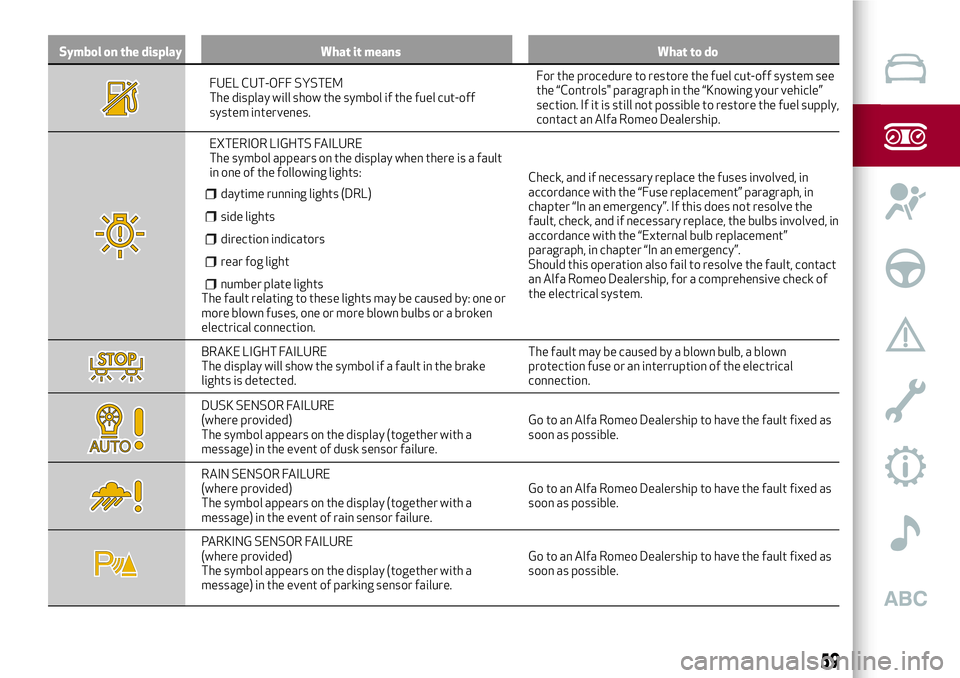
Symbol on the display What it means What to do
FUEL CUT-OFF SYSTEM
The display will show the symbol if the fuel cut-off
system intervenes.For the procedure to restore the fuel cut-off system see
the âControls" paragraph in the âKnowing your vehicleâ
section. If it is still not possible to restore the fuel supply,
contact an Alfa Romeo Dealership.
EXTERIOR LIGHTS FAILURE
The symbol appears on the display when there is a fault
in one of the following lights:
daytime running lights (DRL)
side lights
direction indicators
rear fog light
number plate lightsThe fault relating to these lights may be caused by: one or
more blown fuses, one or more blown bulbs or a broken
electrical connection.Check, and if necessary replace the fuses involved, in
accordance with the âFuse replacementâ paragraph, in
chapter âIn an emergencyâ. If this does not resolve the
fault, check, and if necessary replace, the bulbs involved, in
accordance with the âExternal bulb replacementâ
paragraph, in chapter âIn an emergencyâ.
Should this operation also fail to resolve the fault, contact
an Alfa Romeo Dealership, for a comprehensive check of
the electrical system.
BRAKE LIGHT FAILURE
The display will show the symbol if a fault in the brake
lights is detected.The fault may be caused by a blown bulb, a blown
protection fuse or an interruption of the electrical
connection.
DUSK SENSOR FAILURE
(where provided)
The symbol appears on the display (together with a
message) in the event of dusk sensor failure.Go to an Alfa Romeo Dealership to have the fault fixed as
soon as possible.
RAIN SENSOR FAILURE
(where provided)
The symbol appears on the display (together with a
message) in the event of rain sensor failure.Go to an Alfa Romeo Dealership to have the fault fixed as
soon as possible.
PARKING SENSOR FAILURE
(where provided)
The symbol appears on the display (together with a
message) in the event of parking sensor failure.Go to an Alfa Romeo Dealership to have the fault fixed as
soon as possible.
59
Page 62 of 212
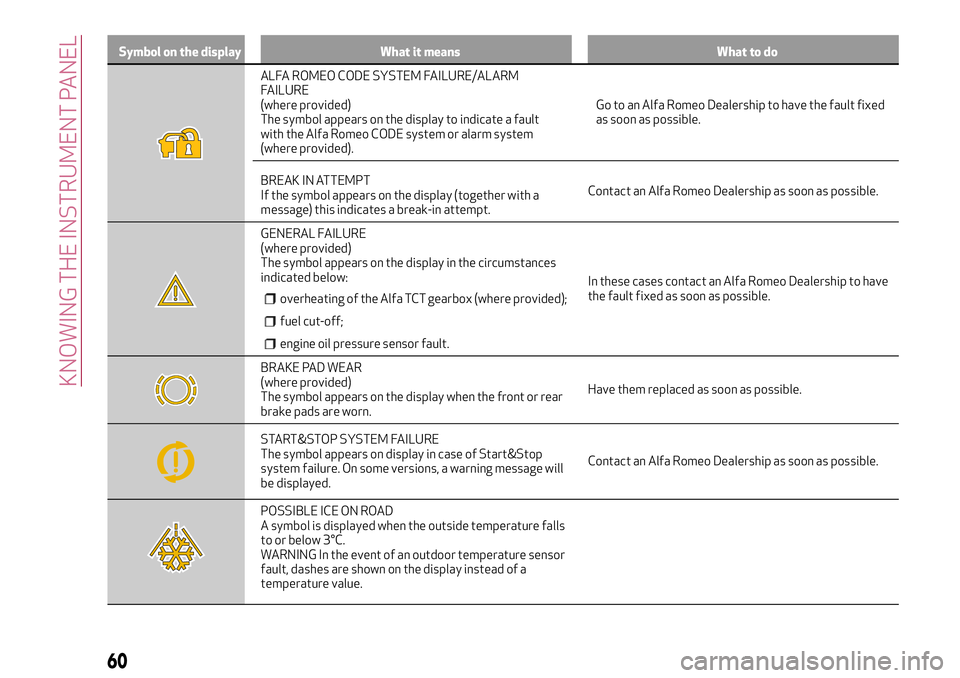
Symbol on the display What it means What to do
ALFA ROMEO CODE SYSTEM FAILURE/ALARM
FAILURE
(where provided)
The symbol appears on the display to indicate a fault
with the Alfa Romeo CODE system or alarm system
(where provided).Go to an Alfa Romeo Dealership to have the fault fixed
as soon as possible.
BREAK IN ATTEMPT
If the symbol appears on the display (together with a
message) this indicates a break-in attempt.Contact an Alfa Romeo Dealership as soon as possible.
GENERAL FAILURE
(where provided)
The symbol appears on the display in the circumstances
indicated below:
overheating of the Alfa TCT gearbox (where provided);
fuel cut-off;
engine oil pressure sensor fault.
In these cases contact an Alfa Romeo Dealership to have
the fault fixed as soon as possible.
BRAKE PAD WEAR
(where provided)
The symbol appears on the display when the front or rear
brake pads are worn.Have them replaced as soon as possible.
START&STOP SYSTEM FAILURE
The symbol appears on display in case of Start&Stop
system failure. On some versions, a warning message will
be displayed.Contact an Alfa Romeo Dealership as soon as possible.
POSSIBLE ICE ON ROAD
A symbol is displayed when the outside temperature falls
to or below 3°C.
WARNING In the event of an outdoor temperature sensor
fault, dashes are shown on the display instead of a
temperature value.
60
KNOWING THE INSTRUMENT PANEL
Page 63 of 212

Symbol on the display What it means What to do
DYNAMIC SUSPENSION FAILURE (active shock
absorber system)
(where provided)
The symbol appears on the display in case of active
shock absorber system failure.Contact an Alfa Romeo Dealership as soon as possible.
61
Page 64 of 212
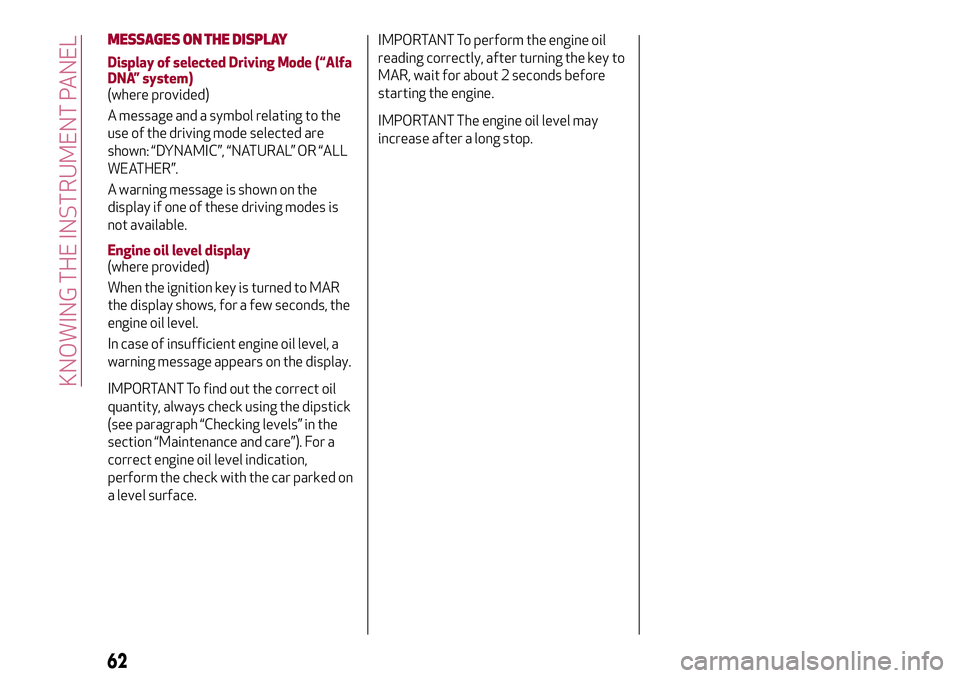
MESSAGES ON THE DISPLAY
Display of selected Driving Mode (âAlfa
DNAâ system)
(where provided)
A message and a symbol relating to the
use of the driving mode selected are
shown: âDYNAMICâ, âNATURALâ OR âALL
WEATHERâ.
A warning message is shown on the
display if one of these driving modes is
not available.
Engine oil level display
(where provided)
When the ignition key is turned to MAR
the display shows, for a few seconds, the
engine oil level.
In case of insufficient engine oil level, a
warning message appears on the display.
IMPORTANT To find out the correct oil
quantity, always check using the dipstick
(see paragraph âChecking levelsâ in the
section âMaintenance and careâ). For a
correct engine oil level indication,
perform the check with the car parked on
a level surface.IMPORTANT To perform the engine oil
reading correctly, after turning the key to
MAR, wait for about 2 seconds before
starting the engine.
IMPORTANT The engine oil level may
increase after a long stop.
62
KNOWING THE INSTRUMENT PANEL
Page 65 of 212
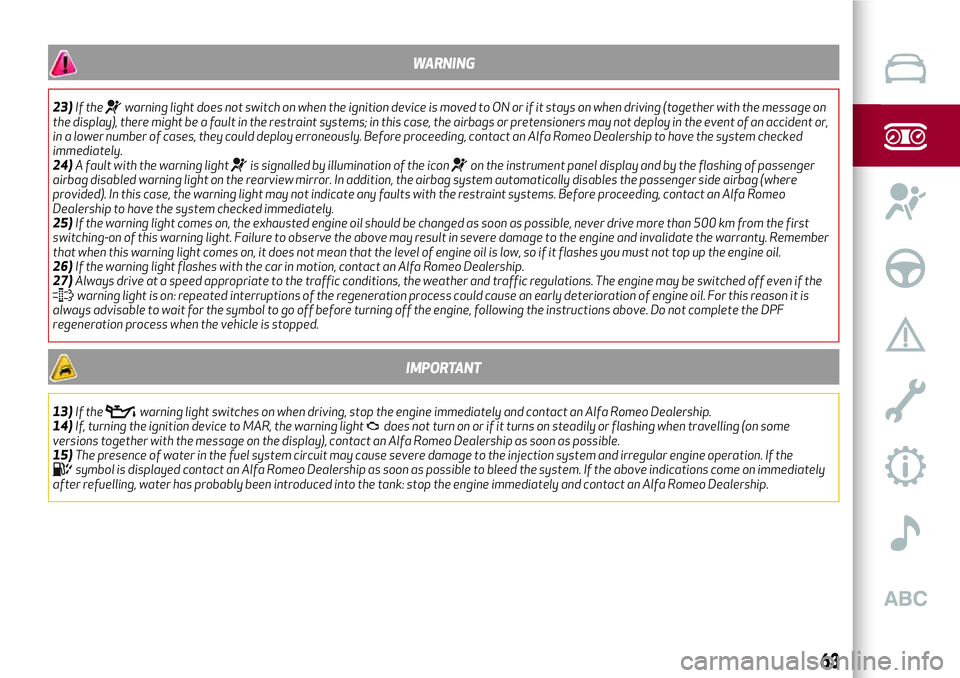
WARNING
23)If thewarning light does not switch on when the ignition device is moved to ON or if it stays on when driving (together with the message on
the display), there might be a fault in the restraint systems; in this case, the airbags or pretensioners may not deploy in the event of an accident or,
in a lower number of cases, they could deploy erroneously. Before proceeding, contact an Alfa Romeo Dealership to have the system checked
immediately.
24)A fault with the warning light
is signalled by illumination of the iconon the instrument panel display and by the flashing of passenger
airbag disabled warning light on the rearview mirror. In addition, the airbag system automatically disables the passenger side airbag (where
provided). In this case, the warning light may not indicate any faults with the restraint systems. Before proceeding, contact an Alfa Romeo
Dealership to have the system checked immediately.
25)If the warning light comes on, the exhausted engine oil should be changed as soon as possible, never drive more than 500 km from the first
switching-on of this warning light. Failure to observe the above may result in severe damage to the engine and invalidate the warranty. Remember
that when this warning light comes on, it does not mean that the level of engine oil is low, so if it flashes you must not top up the engine oil.
26)If the warning light flashes with the car in motion, contact an Alfa Romeo Dealership.
27)Always drive at a speed appropriate to the traffic conditions, the weather and traffic regulations. The engine may be switched off even if the
warning light is on: repeated interruptions of the regeneration process could cause an early deterioration of engine oil. For this reason it is
always advisable to wait for the symbol to go off before turning off the engine, following the instructions above. Do not complete the DPF
regeneration process when the vehicle is stopped.
IMPORTANT
13)If thewarning light switches on when driving, stop the engine immediately and contact an Alfa Romeo Dealership.
14)If, turning the ignition device to MAR, the warning lightdoes not turn on or if it turns on steadily or flashing when travelling (on some
versions together with the message on the display), contact an Alfa Romeo Dealership as soon as possible.
15)The presence of water in the fuel system circuit may cause severe damage to the injection system and irregular engine operation. If the
symbol is displayed contact an Alfa Romeo Dealership as soon as possible to bleed the system. If the above indications come on immediately
after refuelling, water has probably been introduced into the tank: stop the engine immediately and contact an Alfa Romeo Dealership.
63
Page 66 of 212

EOBDSYSTEM (European On
Board Diagnosis)
(where provided)
Operation
The EOBD system (European On Board
Diagnosis) carries out a continuous
diagnosis of the components of the car
related to emissions.
It also alerts the driver, by switching on
the warning light
on the instrument
panel, together with a message on the
display, when these components are no
longer in peak condition (see âWarning
lights and messagesâ paragraph in the
"Knowing the instrument panel" chapter).
The aim of the EOBD system (European
On Board Diagnosis) is to:
monitor the efficiency of the system;
indicate an increase in emissions;
indicate the need to replace damaged
components.
The vehicle also has a connector, which
can interface with appropriate tools, that
makes it possible to read the error codes
stored in the electronic control units
together with a series of specific
parameters for engine operation and
diagnosis. This check can also be carried
out by the traffic police.
IMPORTANT After eliminating a fault, to
check the system completely, the Alfa
Romeo Dealership is obliged to run tests
and, if necessary, road tests which may
also require a long journey.
64
KNOWING THE INSTRUMENT PANEL
Page 67 of 212
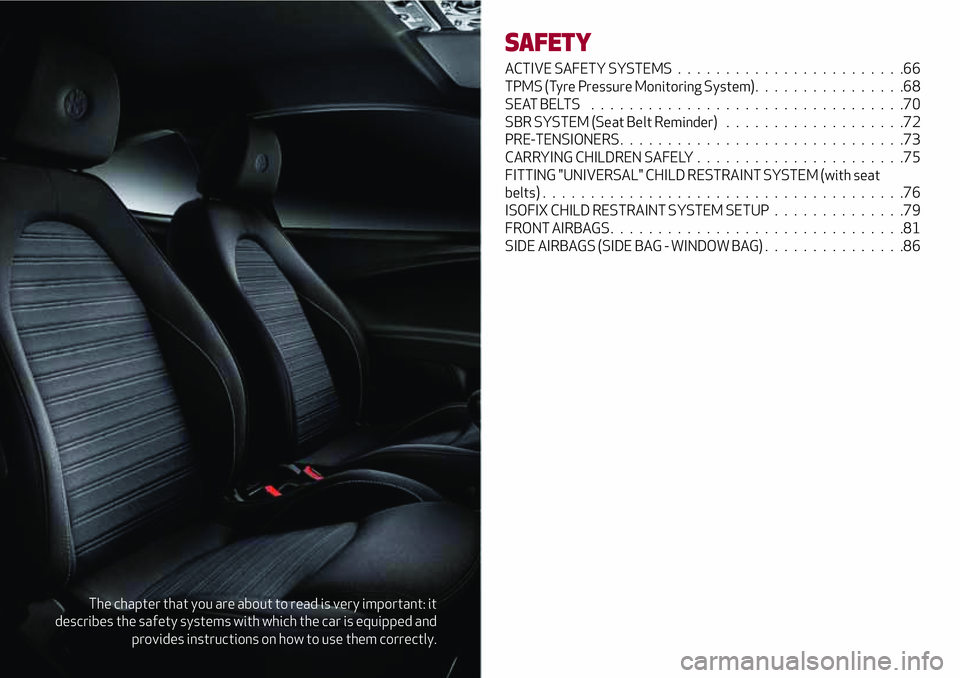
The chapter that you are about to read is very important: it
describes the safety systems with which the car is equipped and
provides instructions on how to use them correctly.
SAFETY
ACTIVE SAFETY SYSTEMS . . . . . . . . ................66
TPMS (Tyre Pressure Monitoring System) ................68
SEATBELTS .................................70
SBR SYSTEM (Seat Belt Reminder) . . . . ...............72
PRE-TENSIONERS . .............................73
CARRYING CHILDREN SAFELY . . . . . .................75
FITTING "UNIVERSAL" CHILD RESTRAINT SYSTEM (with seat
belts)......................................76
ISOFIX CHILD RESTRAINT SYSTEM SETUP . . . . . . . . . . . . . .79
FRONT AIRBAGS . . .............................81
SIDE AIRBAGS (SIDE BAG - WINDOW BAG) . . . . . . .........86
Page 68 of 212

ACTIVE SAFETYSYSTEMS
ABS SYSTEM
33) 34) 35) 36) 37) 38) 39)
This system, which is an integral part of
the braking system, prevents one or more
wheels from locking and slipping in all
road surface conditions, irrespective of
the intensity of the braking action,
ensuring that the vehicle can be
controlled even during emergency
braking and optimising stopping
distances.
System intervention
The driver can feel that the ABS system
has come into action because the brake
pedal pulsates slightly and the system
gets noisier: this is entirely normal with
the system operating.
ASR (AntiSlip Regulation)SYSTEM
40) 41) 42)
This is an integral part of the ESC system
and automatically operates in the event
of one or both drive wheels slipping, loss
of grip on wet roads (aquaplaning) and
acceleration on slippery, snowy or icy
roads, etc.System intervention
The system operates on the engine
power and brakes.
This is indicated by the flashing of the
warning light
on the instrument panel,
to inform the driver that the car is in
critical stability and grip conditions.
BRAKE ASSISTSYSTEM (assistance
during emergency braking)
The system, which cannot be turned off,
recognises emergency braking (on the
basis of the brake pedal operating speed)
and speeding up the response of the
braking system. The Brake Assist device
is deactivated if there is a ESC system
failure.
MSR (Motor Schleppmoment
Regelung)SYSTEM
The system prevents the drive wheels
from possibly locking, which could
happen, for example, if the accelerator
pedal is released suddenly or in the case
of a sudden downshifting in conditions of
poor grip.
In this conditions, the engine braking
effect could cause the drive wheels to
slip, resulting in a loss of vehicle stability.
In these situations, the system
intervenes, restoring torque to the
engine in order to conserve vehicle
stability and increase vehicle safety.
DST SYSTEM (Dynamic Steering
Torque)
46)
This function integrates Dual Pinion
active steering into the operation of ESC.
For particular manoeuvres, the ESC
system controls the steering to actuate a
steering torque and assist the driver in
the best possible way.
The system operates the brakes and
steering in a coordinated manner to
increase the suspension and safety level
of the car as a whole. The steering
provides additional torque on the
steering wheel.
EBD SYSTEM
The EBD system is an integral part of the
ESC system and intervenes during
braking, distributing the brake force
optimally between front and rear wheels.
This guarantees greater braking stability
for the car, preventing sudden locking of
the rear wheels and the consequent
instability of the car.
ESC SYSTEM
28) 29) 30) 31) 32)
The ESC system improves the directional
control and stability of the car in various
driving conditions.
66
SAFETY
Page 69 of 212
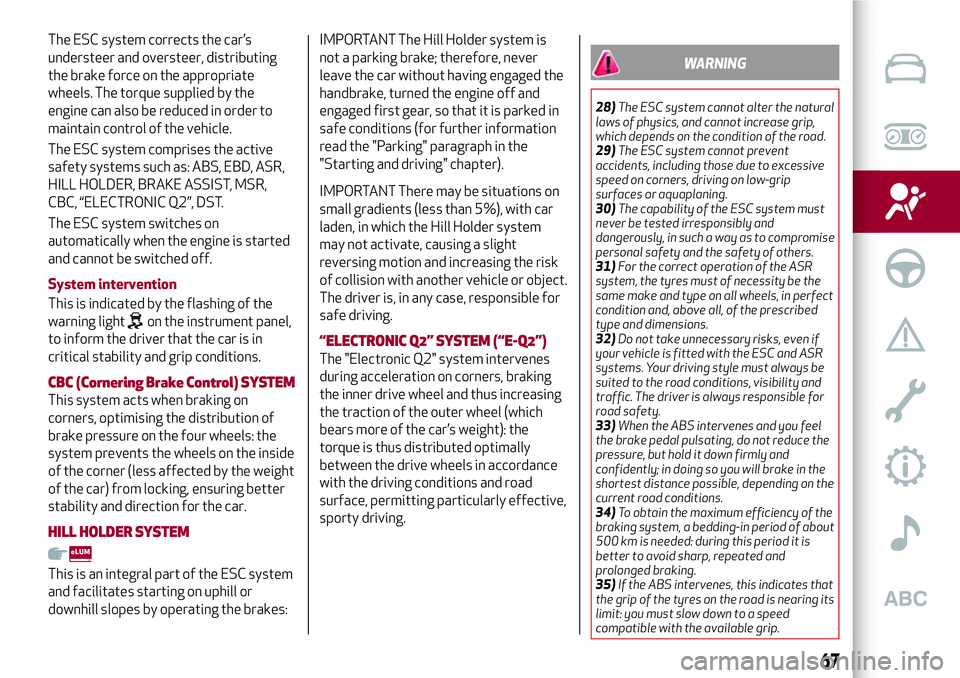
The ESC system corrects the carâs
understeer and oversteer, distributing
the brake force on the appropriate
wheels. The torque supplied by the
engine can also be reduced in order to
maintain control of the vehicle.
The ESC system comprises the active
safety systems such as: ABS, EBD, ASR,
HILL HOLDER, BRAKE ASSIST, MSR,
CBC, âELECTRONIC Q2â, DST.
The ESC system switches on
automatically when the engine is started
and cannot be switched off.
System intervention
This is indicated by the flashing of the
warning light
on the instrument panel,
to inform the driver that the car is in
critical stability and grip conditions.
CBC (Cornering Brake Control)SYSTEM
This system acts when braking on
corners, optimising the distribution of
brake pressure on the four wheels: the
system prevents the wheels on the inside
of the corner (less affected by the weight
of the car) from locking, ensuring better
stability and direction for the car.
HILL HOLDERSYSTEM
This is an integral part of the ESC system
and facilitates starting on uphill or
downhill slopes by operating the brakes:
IMPORTANT The Hill Holder system is
not a parking brake; therefore, never
leave the car without having engaged the
handbrake, turned the engine off and
engaged first gear, so that it is parked in
safe conditions (for further information
read the "Parking" paragraph in the
"Starting and driving" chapter).
IMPORTANT There may be situations on
small gradients (less than 5%), with car
laden, in which the Hill Holder system
may not activate, causing a slight
reversing motion and increasing the risk
of collision with another vehicle or object.
The driver is, in any case, responsible for
safe driving.
âELECTRONIC Q2âSYSTEM (âE-Q2â)
The "Electronic Q2" system intervenes
during acceleration on corners, braking
the inner drive wheel and thus increasing
the traction of the outer wheel (which
bears more of the carâs weight): the
torque is thus distributed optimally
between the drive wheels in accordance
with the driving conditions and road
surface, permitting particularly effective,
sporty driving.
WARNING
28)The ESC system cannot alter the natural
laws of physics, and cannot increase grip,
which depends on the condition of the road.
29)The ESC system cannot prevent
accidents, including those due to excessive
speed on corners, driving on low-grip
surfaces or aquaplaning.
30)The capability of the ESC system must
never be tested irresponsibly and
dangerously, in such a way as to compromise
personal safety and the safety of others.
31)For the correct operation of the ASR
system, the tyres must of necessity be the
same make and type on all wheels, in perfect
condition and, above all, of the prescribed
type and dimensions.
32)Do not take unnecessary risks, even if
your vehicle is fitted with the ESC and ASR
systems. Your driving style must always be
suited to the road conditions, visibility and
traffic. The driver is always responsible for
road safety.
33)When the ABS intervenes and you feel
the brake pedal pulsating, do not reduce the
pressure, but hold it down firmly and
confidently; in doing so you will brake in the
shortest distance possible, depending on the
current road conditions.
34)To obtain the maximum efficiency of the
braking system, a bedding-in period of about
500 km is needed: during this period it is
better to avoid sharp, repeated and
prolonged braking.
35)If the ABS intervenes, this indicates that
the grip of the tyres on the road is nearing its
limit: you must slow down to a speed
compatible with the available grip.
67
Page 70 of 212
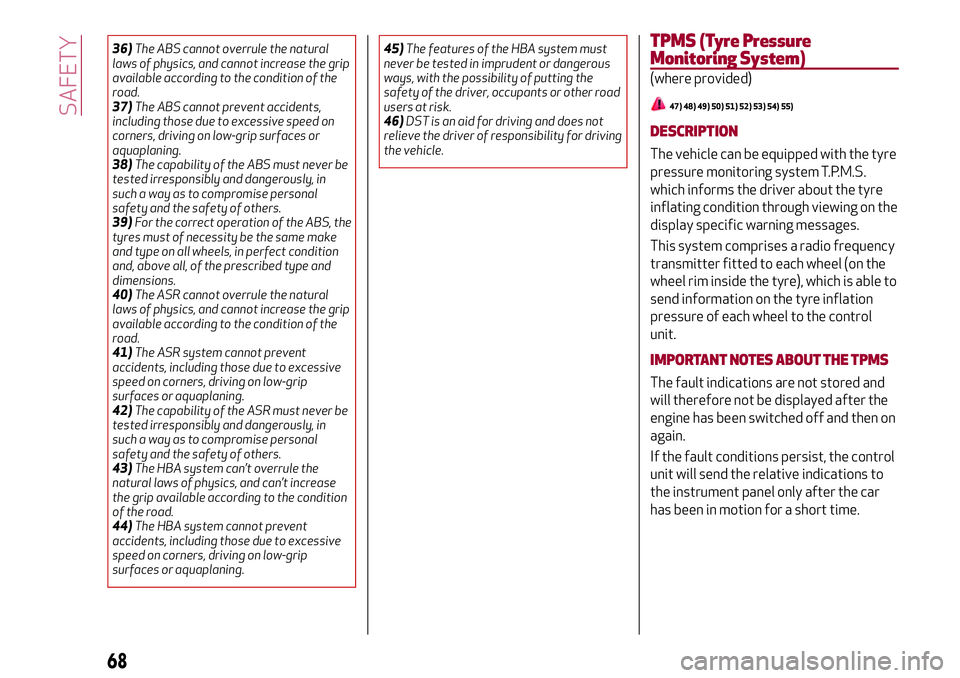
36)The ABS cannot overrule the natural
laws of physics, and cannot increase the grip
available according to the condition of the
road.
37)The ABS cannot prevent accidents,
including those due to excessive speed on
corners, driving on low-grip surfaces or
aquaplaning.
38)The capability of the ABS must never be
tested irresponsibly and dangerously, in
such a way as to compromise personal
safety and the safety of others.
39)For the correct operation of the ABS, the
tyres must of necessity be the same make
and type on all wheels, in perfect condition
and, above all, of the prescribed type and
dimensions.
40)The ASR cannot overrule the natural
laws of physics, and cannot increase the grip
available according to the condition of the
road.
41)The ASR system cannot prevent
accidents, including those due to excessive
speed on corners, driving on low-grip
surfaces or aquaplaning.
42)The capability of the ASR must never be
tested irresponsibly and dangerously, in
such a way as to compromise personal
safety and the safety of others.
43)The HBA system canât overrule the
natural laws of physics, and canât increase
the grip available according to the condition
of the road.
44)The HBA system cannot prevent
accidents, including those due to excessive
speed on corners, driving on low-grip
surfaces or aquaplaning.45)The features of the HBA system must
never be tested in imprudent or dangerous
ways, with the possibility of putting the
safety of the driver, occupants or other road
users at risk.
46)DST is an aid for driving and does not
relieve the driver of responsibility for driving
the vehicle.TPMS (Tyre Pressure
Monitoring System)
(where provided)
47) 48) 49) 50) 51) 52) 53) 54) 55)
DESCRIPTION
The vehicle can be equipped with the tyre
pressure monitoring system T.P.M.S.
which informs the driver about the tyre
inflating condition through viewing on the
display specific warning messages.
This system comprises a radio frequency
transmitter fitted to each wheel (on the
wheel rim inside the tyre), which is able to
send information on the tyre inflation
pressure of each wheel to the control
unit.
IMPORTANT NOTES ABOUT THE TPMS
The fault indications are not stored and
will therefore not be displayed after the
engine has been switched off and then on
again.
If the fault conditions persist, the control
unit will send the relative indications to
the instrument panel only after the car
has been in motion for a short time.
68
SAFETY